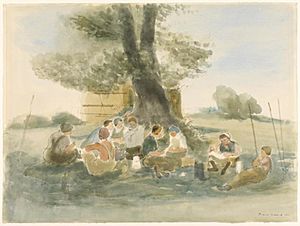Mona Moore facts for kids
Quick facts for kids
Mona Moore
|
|
|---|---|
| Born | 20 March 1917 London, England
|
| Died | 20 September 2000 (aged 83) Oxford, England
|
| Nationality | British |
| Education |
|
| Known for | Painting, drawing |
Mona Mary Moore (born March 20, 1917 – died September 20, 2000) was a talented British painter and illustrator. She was also known as Mona Bentin and later as Deborah Bentin. Mona Moore is best known for her amazing artwork during World War Two. She created art for important projects like Recording Britain and the War Artists' Advisory Committee. Her drawings and paintings also appeared often in popular magazines such as Good Housekeeping, the Radio Times, and The Listener.
Early Life and Art School
Mona Moore was born in London. She went to school at St. Martin's-in-the-Fields. When she was just 14 years old, she won a scholarship to study at the St Martin's School of Art. This scholarship helped her stay at St. Martin's until she was 19.
After that, Moore continued her art studies at the Central School of Arts and Crafts. There, she learned a special printing technique called lithography. This is a way of printing images using a flat stone or metal plate. She finished her studies in 1939. That same summer, she married Tony Bentin, who was also an art student.
Art During World War Two
When World War Two began, Mona Moore's husband, Tony Bentin, joined the Royal Artillery. He worked on an anti-aircraft battery in England, helping to protect the country from air attacks. Mona Moore also used her artistic skills to help with the war effort.
She started working as an artist for the Pilgrim Trust on a project called Recording Britain. This project aimed to create a record of Britain's landscapes and buildings. Moore had family connections in the Gower Peninsula near Swansea, Wales. She was allowed to go there and paint landscapes for the project.
After her first trip, the Pilgrim Trust asked her to return to Gower to paint more landscapes. Mona arrived back in Swansea in March 1941. This was shortly after the city had been heavily bombed for three days, an event known as the Swansea Blitz. Seeing how much of the city center was destroyed, she decided to stay in Swansea. She wanted to draw the bomb damage and show how people were working to rebuild.
One morning, Mona went back to finish a picture she had started near Swansea Castle. She found that the pile of rubble she was drawing on had been blocked off. An unexploded bomb had been found underneath it overnight! A photograph of Mona sketching on the rubble heap the day before was even printed on the front page of the South Wales Evening Post newspaper.
The Pilgrim Trust then asked Mona to draw construction work at a new airfield being built in Norfolk. Even though she had permission to sketch there, the Royal Air Force (RAF) arrested her. She was held for several hours until a local police officer interviewed her and let her go. Mona also painted street scenes in Great Yarmouth for the Recording Britain project. In total, 20 of her paintings from Wales and eight from Norfolk were accepted for the project.
In August 1941, another important group, the War Artists' Advisory Committee (WAAC), asked Mona Moore to paint the Women's Land Army. These were women who worked on farms to help with the harvest in Essex. Mona created several paintings about them. WAAC paid her for three of these artworks.
Kenneth Clark, who was the director of the National Gallery in London, also gave Mona a secret job. He asked her to go to Blaenau Ffestiniog in Wales. This was a disused slate mine where valuable paintings from the National Gallery had been hidden to protect them from the bombings. Mona later said it was an "amazing experience" to go into the mine and see "priceless Rembrandts, Van Dycks and Turners" stacked safely. She spent three weeks there, and Clark later gave her drawings as thank-you gifts to the staff who had helped move the art collection.
Mona Moore's paintings from East Anglia were shown in an exhibition at the National Gallery in London in June 1942. Also, during the war in 1944, Mona created 16 colorful prints and the cover picture for a book called Sea Poems by Myfanwy Piper. Her painting The Agony in the Garden won a £200 first prize in a competition for religious art.
After the War
After World War Two ended, Mona Moore worked regularly as an illustrator. Her drawings appeared in many publications, including the Radio Times, the Daily Express, Good Housekeeping, and The Listener. For the Radio Times, she drew pictures for radio plays like The Cherry Orchard by Anton Chekhov and They by Rudyard Kipling.
In 1948, she designed two posters for London Transport Executive called London's Open Air, The Trees. She also designed the covers for the first two books by author Alan Sillitoe: Saturday Night and Sunday Morning (1958) and The Loneliness of the Long Distance Runner (1959).
Mona and her husband both became followers of the Subud spiritual movement. They also both changed their names, becoming known as Phillip and Deborah Bentin. Sadly, in the 1960s, Mona developed an eye infection that caused her to become blind. This meant she could no longer continue her artistic career.
Mona Moore wrote a book about her life that was never published. She also gave interviews about her experiences to art historian Gill Clarke and the Imperial War Museum. Today, you can find Mona Moore's paintings in important museums like the Imperial War Museum, the Victoria and Albert Museum, and the British Museum. Her artworks were also part of a special exhibition called War Fields in 2004.
Images for kids



